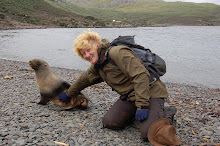 Slush forms in the sea when the temperature falls below -2°C and here is seen washed up on the shoreline
Slush forms in the sea when the temperature falls below -2°C and here is seen washed up on the shoreline
 This seal has probably the best view on the island, from its spot high in Mountain Cwm - surrounded by the eastern Bird Island peaks and overlooking South Georgia at its wintery finest
This seal has probably the best view on the island, from its spot high in Mountain Cwm - surrounded by the eastern Bird Island peaks and overlooking South Georgia at its wintery finest
 A seal sleeps at an altitude of 150m in Mountain Cwm, overlooking Bird Sound and Cape Alexandra, South Georgia
A seal sleeps at an altitude of 150m in Mountain Cwm, overlooking Bird Sound and Cape Alexandra, South Georgia
 Mountain Cwm, a large scree-lined coire to the east of the island, and arguably the best ski run (when there is plenty of snow)
Mountain Cwm, a large scree-lined coire to the east of the island, and arguably the best ski run (when there is plenty of snow)
 Macaroni Cwm (so named because of the macaroni penguin colony there) with the north coast of South Georgia in the distance
Macaroni Cwm (so named because of the macaroni penguin colony there) with the north coast of South Georgia in the distance
Bird Island, and South Georgia, lie south of the Antarctic polar front, also called the Antarctic Convergence. This is the boundary between mild South Atlantic water, and cold Antarctic water. This means that despite our low latitude (when compared with other BAS bases, Rothera and Halley, and even with that of the UK) we experience a sub-Antarctic climate.
Bird Island lies 54 degrees south of the equator. This is actually slightly north of Cape Horn. To put this in perspective, Harrogate, Bridlington and Lancaster in England lie 54 degrees north of the equator, and the Shetland Isles lie north of 60 degrees north. The reason the UK is relatively mild, and South Georgia is colder, is due to ocean currents.
The UK and northern Europe is warmed by the North Atlantic current, an extension of the Gulf stream: a current which originates in the Gulf of Mexico and follows the eastern coast of North America before crossing the North Atlantic. Without the effect of this current, north west Europe would be much colder than it is.
The Antarctic polar front marks the boundary between ~5°C South Atlantic water, and Antarctic water which is generally 2°C or below. This is why South Georgia, and Bird Island, experiences a colder climate year-round than might be expected for a location of this latitude. Temperatures on Bird Island have not risen above 10°C during the 22 months I have been here - although nor have they fallen below -10°C.
So, with the snow of the last few weeks, the island has taken on a more wintery look. The streams have frozen solid and travel around the island is facilitated by the use of crampons and snow shoes.





2 comments:
Bonjour Ewan,
That's good to see pictures of the island you should post more even without comments ;)
Gorfou
Thanks Gorfou - I will try to post more pictures. I agree, its a good idea.
Ewan
Post a Comment